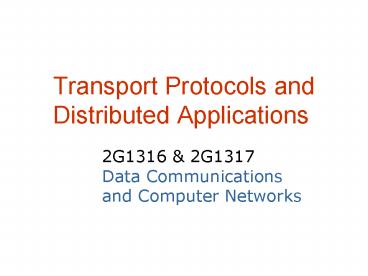Transport Protocols and Distributed Applications - PowerPoint PPT Presentation
1 / 31
Title:
Transport Protocols and Distributed Applications
Description:
CGI, PHP, ASP, ... Get a program from the server and run it on the client. Active pages ... Dynamic Host Configuration Protocol. IP address. Static or dynamic ... – PowerPoint PPT presentation
Number of Views:40
Avg rating:3.0/5.0
Title: Transport Protocols and Distributed Applications
1
- Transport Protocols and Distributed Applications
2G1316 2G1317Data Communications and Computer
Networks
2
Illustrations in this material are collected from
Behrouz A Forouzan, Data Communications and
Networking, 3rd edition, McGraw-Hill.
3
Todays Lecture
- Transport Protocols
- End-to-end packet transmission
- TCPconnection-oriented transmission
- UDPdatagram transmission
- Distributed Applications
- the Client-Server communication model
- DNS, Mail, FTP, WWW, SNMP
- DHCP
4
Transport Protocols
- End-to-end (process-to-process) transport service
for applications
LAN1
LAN2
Host1
Host2
Router
TCP
TCP
IP
IP
IP
MAC1
MAC1
MAC2
MAC2
PHY
PHY
PHY
PHY
5
Application Addressing
UDP/TCP Port
IP Protocol
6
Client-Server Model
- Server uses a well known port number
- IANAInternet Assigned Numbers Authority
- Client port numbers are assigned dynamically
- Ephemeral ports
7
Some Well Known Port Numbers
8
User Datagram Protocol (UDP)
- Connectionless datagram service
9
Why Datagrams?
- Application doesnt need a reliable service
- Periodic updates, statistics, etc
- Connection-oriented service too costly
- Overhead with connection management
- Application does flow and error control itself
- Retransmissions are useless
- When a packet is lost, its lost
10
Transmission Control Protocol (TCP)
11
Round Trip Time Estimation
12
Network Congestion
- More packets than the network can handle
- Throughput decreases
- Delay becomes infinite
13
How Much Data in Each Burst?
sender window min(receiver window, congestion
window)
- Receiver windowadvertised by receiver
- Congestion windowTCP congestion control
14
TCP Congestion Window Size
Transmission round
15
TCP Summary
- Connection-oriented
- Point-to-point
- Stream-oriented
- Byte sequence numbers
- Sliding window
- Go-back-N
- Adaptive retransmission timer
- Round-trip time estimates based on measurements
- Congestion control
- Packet loss indicates congestion
16
Applications
- Domain Name System (DNS)
- to allow symbolic names instead of numeric IP
addresses - Simple Message Transfer Protocol (SMTP)
- the basic protocol of e-mail communication
- File Transfer Protocol (FTP)
- Hypertext Transfer Protocol (HTTP) for Web
browsing - Simple Network Management Protocol (SNMP)
- To manage network devices
- Dynamic Host Configuration Protocol (DHCP)
- Autoconfiguration
17
Domain Name System (DNS)
- Translate host name to IP address
- www.imit.kth.se ? 130.237.203.50
- 3 generations of translations
- HOSTS.TXT
- DNS
- Dynamic DNS
18
Hierarchical Name Space
- www.imit.kth.se, ftp.internic.net, google.com, ...
19
Hierarchy of Name Servers
- Root servers (13, currently)
- List of addresses available from ftp.internic.net
20
Name Lookup (Resolution)
- Request/response
- A client is assigned a set of DNS servers
- Through configuration
- DNS servers remember previous lookups
- Caching
21
Simple Mail Transfer Protocol (SMTP)
- SMTP delivers mail to a users mailbox
- Normally via an outgoing SMTP mail server
22
SMTP Mail Format
- Plain text
- MIME encoding of non-text data
- Multipurpose Internet Mail Extension
Mail From alice_at_red.orgRCPT TO bob_at_blue.com
From AliceTo BobDate 2004-02-19
0801Subject Important mail Please read
carefully!
23
User Mail Delivery
POP, IMAP, WWW, ...
24
File Transfer Protocol (FTP)
- File transfers between computers
- TCP
- Normally two connections
- Data and control (ports 20 and 21)
25
World Wide Web
- Distributed system
- CERN 1989
- Hypertext
- HTMLHypertext Markup Language
26
Hypertext Transfer Protocol (HTTP)
27
Non-Static Pages
- Run a program on the server to create the page
- Dynamic pages
- CGI, PHP, ASP, ...
- Get a program from the server and run it on the
client - Active pages
- Java, JavaScript, ...
28
Network Management
- Simple Network Management Protocol (SNMP)
- To monitor and control network devices (interface
cards, routers, etc.) - Elements
- manager machine with special software (client)
- agents small software in each managed device
(server) - management information base (MIB) the set of
managable objects in each device - Processes
- the manager gets and sets parameters from the MIB
- agents notify the manager of significant events
- UDP, port 161
29
Dynamic Host Configuration Protocol
Internet
Default router
Subnet
DNS server
- IP address
- Static or dynamic (leasing)
- Subnet mask
- IP address of default router
- IP address of DNS server
30
Summary
- Transport protocols
- TCP how to achieve reliable transfer over IP
- retransmission
- congestion control
- UDP an unreliable transport protocol
- Distributed applications
- the client-server model
- Applications
- DNS
- SMTP
- FTP
- SNMP
- HTTP
- DHCP
31
Reading Instructions
- Behrouz A. Forouzan, Data Communications and
Networking, third edition - 21 Transport Layer
- 22 Process-to-Process Delivery UDP and TCP
- 22.1 Process-to-process delivery
- 22.2 User Datagram Protocol (UDP)
- 22.3 Transmission Control Protocol (TCP)
- 23 Congestion Control and Quality of Service
- 23.2 Congestion
- 23.4 Two examples
- (Congestion control in TCP)
- 24 Client-Server Model Socket Interfaces
- 21.1 Client-server model
- 25 Domain Name System (DNS)
- 26 Electronic Mail (SMTP) and File Transfer (FTP)
- 27 HTTP and WWW































